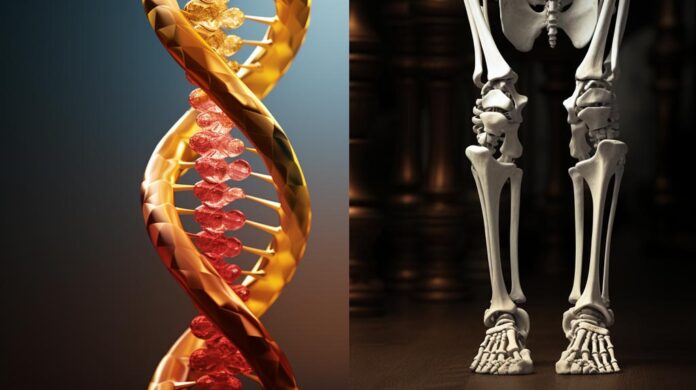Understanding the importance of Vitamin D is like unlocking a secret formula for overall wellbeing. It does far more than simply aid in calcium absorption for strong bones. It’s a guardian against debilitating conditions such as osteoporosis.
Yet, the story of Vitamin D continues beyond skeletal health. This nutrient is a multitasker, critical for muscle function, nerve signalling, and immune response. Think of it as the backstage crew in a theatre production, ensuring everything runs smoothly but seldom in the limelight.
In this post, we’re pulling back the curtain on Vitamin D. We’ll dissect its modern relevance and why it’s not just a health supplement but a necessity. We’ve covered you, from the quandary of sunlight exposure to the debate between diet and supplements.
What lies ahead is more than a simple discussion. It’s an exploration into the multi-dimensional roles of Vitamin D. Special cases, deficiency risks, and the ongoing dialogue on the importance of Vitamin D will all take centre stage.
Importance of Vitamin D in Modern Times
In today’s fast-paced, urbanised world, the importance of Vitamin D has ascended beyond its traditional role in bone maintenance. With lifestyles increasingly confined to indoor spaces, the broad physiological functions of this vital nutrient garner less attention than they critically deserve. Whether it’s metabolic regulation or immune defence, Vitamin D is a linchpin in our overall health.
The modern focus on preventive healthcare elevates the importance of Vitamin D to a new level. Particularly in ageing societies, where age-related health issues are becoming a common concern, the role in reducing the risk of falls among the elderly is more relevant than ever. Given the surge in geriatric populations and the consequent rise in age-associated ailments, ensuring optimal Vitamin D levels is imperative.
For the following, we will methodically explore the various dimensions that underscore Vitamin D’s importance in 21st-century health and wellbeing.
- Bone Health Importance: Severe vitamin D deficiency causes significant health issues, like rickets. Furthermore, lower 25-OHD (25-hydroxycholecalciferol – 25(OH)D3) levels have been associated with various medical conditions. Current evidence supports vitamin D supplementation for preventing fractures, especially when administered with calcium. It also helps prevent falls and slightly reduce mortality, particularly in older patients.
- Fall Prevention Importance: Small observational studies have found an association between low vitamin D levels and falls among elderly patients in long-term care. Vitamin D supplementation may reduce the number of falls among the elderly.
- Fracture Prevention Importance: Observational studies support a relationship between low vitamin D levels and fractures. Vitamin D appears to reduce the risk of fractures when given at moderate doses along with calcium.
- Respiratory Infection Prevention Importance: A large cohort study suggested that upper respiratory tract infections are more common in people with low vitamin D levels. However, supplementation does not prevent or reduce respiratory tract infections (RTIs) in Western populations.
- Mortality Importance: Multiple observational studies have found a positive association between low vitamin D levels and an increase in all-cause mortality. The effects of vitamin D on mortality are not consistently statistically significant.

Why Vitamin D is Crucial for Health
The importance of Vitamin D in immune function has gained considerable attention for over 25 years. Its immunomodulatory actions were known, but its significance in human physiology has come to light only recently. Two main factors contribute to this revised perspective.
1. Vitamin D and Immune Disorders
A growing body of data links vitamin D insufficiency with prevalent immune disorders such as multiple sclerosis, type 1 diabetes, and Crohn’s disease. More recent studies even suggest a link between low vitamin D levels and infections like tuberculosis.
2. Mechanisms in the Immune System
The second factor is our improved understanding of how vitamin D interacts with the immune system. Cells from the immune system can convert 25OHD to its active form, impacting various immune responses. For instance, it plays a role in antimicrobial macrophage reactions and regulates T-cell function.
After examining these two pivotal factors, it becomes clear that the scope of Vitamin D’s importance is broad. The following sections explore additional dimensions of Vitamin D’s role in health, from historical perspectives to its impact on specific diseases and conditions.
- Historical Perspective: Historically, the impact of Vitamin D on health was recognised as early as 1903 when Niels Finsen received a Nobel Prize for curing Lupus Vulgaris through light exposure. Cod liver oil, rich in vitamin D, was also used to treat tuberculosis (TB).
- Broad Spectrum of Influence: Recent studies emphasise vitamin D’s overall effects on innate and adaptive immune responses. It can influence a wide range of immune disorders, exceptionally infectious and autoimmune diseases.
- Role in Autoimmune Diseases: Low vitamin D status has been linked to increased risk or severity of autoimmune diseases. For example, vitamin D deficiency in early life accelerates Type 1 diabetes.
- Importance in inflammatory bowel disease (IBD) and Crohn’s Disease: Patients with Crohn’s disease often have decreased serum levels of 25OHD, and vitamin D plays a crucial role in the pathophysiology of IBD.
- Impact on B-Cells: Vitamin D can also act on B-cells to suppress cell proliferation and immunoglobulin production. It can inhibit the differentiation of plasma cells and class-switched memory cells.
By examining these factors, it becomes clear that the importance of Vitamin D extends far beyond bone health. It’s a linchpin in our immune system and is vital to our overall health and wellbeing.

Recommended Vitamin D Intake: How Much Is Too Much?
Understanding the importance of Vitamin D also means knowing the right amount needed for optimal health. While ultraviolet radiation (UVR) is essential for the body’s vitamin D production, excessive UVR exposure can be harmful. Oral vitamin D supplementation is often recommended for those with limited sun exposure—due to geographical location or lifestyle.
The Recommended Dietary Allowance (RDA) provides a guideline for adequate vitamin D intake, expressed in micrograms (mcg) and international units (IU). One microgram of vitamin D is equivalent to 40 IU.
These units are tailored to meet the nutrient requirements of nearly all healthy individuals and are commonly used to plan nutritionally adequate diets. For specific RDA values in both mcg and IU, refer to Table 1 below.
| Table 1: Life Stage & Recommended Amount | |
| Life Stage | Recommended Amount |
| Birth to 12 months | 10 mcg (400 IU) |
| Children 1–13 years | 15 mcg (600 IU) |
| Teens 14–18 years | 15 mcg (600 IU) |
| Adults 19–70 years | 15 mcg (600 IU) |
| Adults 71 years and older | 20 mcg (800 IU) |
| Pregnant and breastfeeding | 15 mcg (600 IU) |
But what’s the upper limit? Excessive vitamin D can lead to nausea, vomiting, and even more severe health issues like kidney failure and irregular heartbeat. The upper intake levels also expressed in mcg and IU, are detailed in Table 2 below.
| Table 2: Ages & Upper Limit | |
| Ages | Upper Limit |
| Birth to 6 months | 25 mcg (1,000 IU) |
| Infants 7–12 months | 38 mcg (1,500 IU) |
| Children 1–3 years | 63 mcg (2,500 IU) |
| Children 4–8 years | 75 mcg (3,000 IU) |
| Children 9–18 years | 100 mcg (4,000 IU) |
| Adults 19 years and older | 100 mcg (4,000 IU) |
| Pregnant and Breastfeeding | 100 mcg (4,000 IU) |
Understanding these guidelines and units, helps you to navigate the importance of Vitamin D in your life, ensuring you’re getting just the right amount for optimal health.
The Sunlight Dilemma
The quandary of Vitamin D’s importance intensifies when winter’s shorter days and weaker UV rays curtail natural synthesis. This affects specific risk groups, amplifying the importance of Vitamin D. The elderly, largely housebound, and individuals with darker skin, particularly those of African, African-Caribbean, and South Asian descent, are most affected.
Research on Seasonal Affective Disorder (SAD) correlates low Vitamin D levels during winter with the condition’s prevalence. This underlines the importance of Vitamin D in mental wellbeing and bone health.
Public health advice recommends Vitamin D supplementation from October to March in winter. This is particularly crucial for those with limited sun exposure, such as the frail, the housebound, and those wearing extensive outdoor clothing.
Added concerns arise for infants reliant on breastfeeding, as Vitamin D transfer through milk is limited. Here, supplementation is essential.
Examining these seasonal and demographic constraints enriches our understanding of Vitamin D’s multifaceted importance. It’s not merely about bone health; it’s a critical factor in circumventing seasonal and demographic challenges to maintain comprehensive wellbeing.

Importance of Vitamin D: Diet vs Supplements
Drawing from our previous discussion about the Sunlight Dilemma, we’re pointing to another significant issue: the importance of Vitamin D obtained from your diet compared to supplements.
While the sun offers us a good amount of Vitamin D from late March to the end of September, a challenge arises during the darker months. Natural sunlight isn’t sufficient for Vitamin D synthesis from October to early March.
Food Sources of Vitamin D:
Firstly, consider natural dietary sources. Oily fish like salmon and sardines, red meat, liver, and egg yolks are abundant in this essential nutrient. But the question remains: are these items frequent guests on your daily menu? Data reveals that such Vitamin D-rich foods are generally not staples in everyday diets. For a comprehensive breakdown of Vitamin D content in various foods, refer to Table 3 below.
| Table 3: Content of vitamin D in Some Foods | |||
| Food | Micrograms (mcg) per serving |
International Units (IU) per serving |
Percent DV* |
| Cod liver oil, 1 tablespoon | 34.0 | 1,360 | 170 |
| Trout (rainbow), farmed, cooked, 3 ounces | 16.2 | 645 | 81 |
| Salmon (sockeye), cooked, 3 ounces | 14.2 | 570 | 71 |
| Mushrooms, white, raw, sliced, exposed to UV light, ½ cup | 9.2 | 366 | 46 |
| Sardines (Atlantic), canned in oil, drained, 2 sardines | 1.2 | 46 | 6 |
| Egg, 1 large, scrambled** | 1.1 | 44 | 6 |
| Liver, beef, braised, 3 ounces | 1.0 | 42 | 5 |
| Tuna fish (light), canned in water, drained, 3 ounces | 1.0 | 40 | 5 |
| Cheese, cheddar, 1.5 ounce | 0.4 | 17 | 2 |
| Mushrooms, portabella, raw, diced, ½ cup | 0.1 | 4 | 1 |
| Chicken breast, roasted, 3 ounces | 0.1 | 4 | 1 |
| Beef, ground, 90% lean, broiled, 3 ounces | 0 | 1.7 | 0 |
| Broccoli, raw, chopped, ½ cup | 0 | 0 | 0 |
| Carrots, raw, chopped, ½ cup | 0 | 0 | 0 |
| Almonds, dry roasted, 1 ounce | 0 | 0 | 0 |
| Apple, large | 0 | 0 | 0 |
| Banana, large | 0 | 0 | 0 |
| Rice, brown, long-grain, cooked, 1 cup | 0 | 0 | 0 |
| Whole wheat bread, 1 slice | 0 | 0 | 0 |
| Lentils, boiled, ½ cup | 0 | 0 | 0 |
| Sunflower seeds, roasted, ½ cup | 0 | 0 | 0 |
| Edamame, shelled, cooked, ½ cup | 0 | 0 | 0 |
| Fortified Foods | |||
| Milk, 2% milkfat, vitamin D fortified, 1 cup | 2.9 | 120 | 15 |
| Soy, almond, and oat milks, vitamin D fortified, various brands, 1 cup | 2.5-3.6 | 100-144 | 13-18 |
| Ready-to-eat cereal, fortified with 10% of the DV for vitamin D, 1 serving | 2.0 | 80 | 10 |
| * DV = Daily Value. ** Vitamin D is in the yolk. mcg = Micrograms and IU: International Units. Data from National Institute of Health | |||
Supplements: A Necessary Addition?
The importance of Vitamin D supplements becomes evident as we age. The skin’s efficiency in synthesising Vitamin D diminishes, especially during winter and in northern latitudes. Supplements offer a consistent and measurable Vitamin D dose, particularly beneficial for those with limited sun exposure or living in less sunny regions.
The Sun’s Role: A Quick Recap
When exposed to ultraviolet rays, the sun instigates the transformation of previtamin D3 from 7-dehydrocholesterol (a type of provitamin D). However, this synthesis can be hampered by age, skin colour, and sunscreen use. A mere 15 minutes in the summer sun can produce up to 10,000 IU of Vitamin D. Yet, the risks of sunburn and DNA damage should not be taken lightly.
The data suggests a multifaceted approach is best for maintaining optimal Vitamin D levels. While dietary sources offer some Vitamin D, they’re often insufficient, particularly for those with specific health conditions affecting Vitamin D absorption. Supplements can fill this gap, especially when natural sunlight is limited.

Concluding Remarks on the Importance of Vitamin D
Unpacking the multi-layered roles of Vitamin D reveals it as more than a mere sidekick to calcium; it’s the unsung hero in the tale of your health. Its importance transcends bone maintenance, moonlighting in critical areas like immune function and metabolic regulation.
The modern urban lifestyle, often confined to indoor spaces, has inadvertently pushed this vital nutrient into the shadows. Yet, as we’ve explored Vitamin D, the stakes are high. The importance of Vitamin D manifests in its links to numerous health issues, from the resurgence of nearly forgotten diseases like rickets to age-related concerns such as falls among the elderly.
The data paints a vivid picture. Seasonal and demographic constraints—be it winter’s weak UV rays or the increased needs of an ageing population—amplify the importance of Vitamin D. These aren’t mere footnotes; they’re headlines in the larger story of Vitamin D’s vital role in comprehensive wellbeing.
So, what have we gained from this post? A nuanced understanding that Vitamin D is not a one-trick pony but a versatile powerhouse, pivotal in maintaining a spectrum of physiological functions. While supplements and dietary sources offer pathways to sustain optimal levels, they are part of a complex, individualised equation we must solve.
Avoiding deficiency is just the starting point; our real goal should be optimal health. In that pursuit, the importance of Vitamin D is more than just supportive; it’s pivotal.
Sources
- Allan GM, Cranston L, Lindblad A, McCormack J, Kolber MR, Garrison S, Korownyk C. Vitamin D: A Narrative Review Examining the Evidence for Ten Beliefs. J Gen Intern Med. 2016 Jul;31(7):780-91.
- Autier, P., Boniol, M., Pizot, C., and Mullie, P., 2014. Vitamin D status and ill health: a systematic review. The Lancet Diabetes & Endocrinology, 2(1), pp.76-89.
- Chen S, Sims GP, Chen XX, Gu YY, Chen S, Lipsky PE. Modulatory effects of 1,25-dihydroxyvitamin D3 on human B cell differentiation. J Immunol. 2007 Aug 1;179(3):1634-47.
- Ginde, A.A., Mansbach, J.M., and Camargo, C.A., 2009. Association between serum 25-hydroxyvitamin D level and upper respiratory tract infection in the Third National Health and Nutrition Examination Survey. Archives of Internal Medicine, 169(4), pp.384-390.
- Gloth FM 3rd, Alam W, Hollis B. Vitamin D vs broad spectrum phototherapy in the treatment of seasonal affective disorder. J Nutr Health Aging. 1999;3(1):5-7.
- Giulietti A, Gysemans C, Stoffels K, van Etten E, Decallonne B, Overbergh L, Bouillon R, Mathieu C. Vitamin D deficiency in early life accelerates Type 1 diabetes in non-obese diabetic mice. Diabetologia. 2004 Mar;47(3):451-62.
- Hewison, M. Vitamin D and immune function: an overview. Proceedings of the Nutrition Society, 2012 Feb;71(1):50-61.
- Institute of Medicine, Food and Nutrition Board. Dietary Reference Intakes for Calcium and Vitamin D. Washington, DC: National Academy Press, 2010. Accessed 6 October 2023.
- Kütting, B.; Drexler, H. Evaluation of Skin-Protective Means against Acute and Chronic Effects of Ultraviolet Radiation from Sunlight. Metab. Disord. Nutr. Correl. Skin 2007, 34, 87–97.
- Lagishetty V, Misharin AV, Liu NQ, Lisse TS, Chun RF, Ouyang Y, McLachlan SM, Adams JS, Hewison M. Vitamin D deficiency in mice impairs colonic antibacterial activity and predisposes to colitis. Endocrinology. 2010 Jun;151(6):2423-32.
- Lai, J.K., Lucas, R.M., Clements, M.S., Roddam, A.W., and Banks, E., 2010. Hip fracture risk in relation to vitamin D supplementation and serum 25-hydroxyvitamin D levels: a systematic review and meta-analysis of randomised controlled trials and observational studies. BMC Public Health, 10(1), pp.1-13.
- Mathieu C, Gysemans C, Giulietti A, Bouillon R. Vitamin D and diabetes. Diabetologia. 2005 Jul;48(7):1247-57.
- National Institutes of Health (NIH), ‘Vitamin D: Fact Sheet for Consumers‘. Accessed 6 October 2023.
- National Institutes of Health (NIH), ‘Vitamin D: Fact Sheet for Health Professionals‘. Accessed 6 October 2023.
- Neville, J.J.; Palmieri, T.; Young, A.R. Physical Determinants of Vitamin D Photosynthesis: A Review. JBMR Plus 2021, 5, e10460.
- Pappa HM, Gordon CM, Saslowsky TM, Zholudev A, Horr B, Shih MC, Grand RJ. Vitamin D status in children and young adults with inflammatory bowel disease. Pediatrics. 2006 Nov;118(5):1950-61.
- Shiozawa S, Shiozawa K, Shimizu S, Fujita T. 1 alpha,25-Dihydroxyvitamin D3 inhibits pokeweed mitogen-stimulated human B-cell activation: an analysis using serum-free culture conditions. Immunology. 1985 May;56(1):161-7.
- Stein, M.S., Wark, J.D., Scherer, S.C., Walton, S.L., Chick, P., Di Carlantonio, M., Zajac, J.D., and Flicker, L., 1999. Falls relate to vitamin D and parathyroid hormone in an Australian nursing home and hostel. J Am Geriatr Soc, 47(10), pp.1195-1201.
- World Health Organization. ‘Ultraviolet Radiation’. Accessed 6 October 2023.



